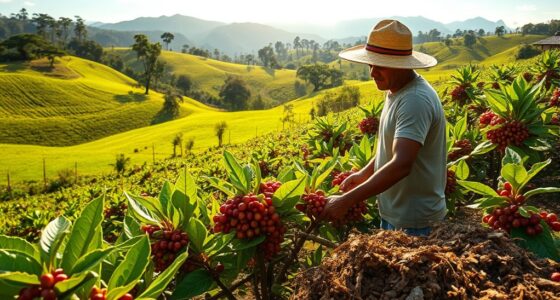Your coffee’s carbon footprint depends on how it’s produced and consumed. For example, a kg of conventional coffee can emit around 15 kg of CO₂, but sustainable options reduce this to about 3.5 kg. Farming practices, processing, and transportation all contribute to emissions. Choosing certified sustainable coffee, using plant-based milk, and being mindful of your consumption can lower your impact considerably. Keep exploring to discover how your choices can make a real difference.
Key Takeaways
- The carbon footprint of coffee varies widely depending on farming practices, with sustainable methods significantly reducing emissions.
- Cultivation and processing contribute about 55% of coffee’s total greenhouse gases, mainly from energy-intensive activities.
- Transportation, especially freight flights, adds a substantial share to coffee’s overall carbon emissions.
- Choosing certified sustainable coffee and plant-based milk options can lower your personal coffee-related carbon footprint.
- Supporting eco-friendly coffee practices helps protect ecosystems, reduce climate change impact, and promote responsible farming.

Coffee’s environmental impact is significant, especially when you consider its carbon footprint. The journey from coffee farm to cup involves numerous stages that contribute to greenhouse gas emissions. A kilogram of Arabica coffee produced in countries like Brazil or Vietnam and exported to the UK releases about 15.33 kg of CO₂, but choosing sustainable coffee can cut this figure down to roughly 3.51 kg. This stark difference highlights how the practices involved in coffee production directly influence its environmental impact.
Choosing sustainable coffee can significantly reduce its carbon footprint from 15.33 kg to about 3.51 kg of CO₂.
The overall carbon footprint of 1 kg of coffee is substantial, producing enough emissions to make approximately 56 espressos, each emitting around 0.28 kg of CO₂. Even everyday drinks like a latte contribute notably to your personal greenhouse gas footprint, with a standard latte generating about 0.55 kg of CO₂. Opting for sustainable production methods can reduce this to roughly 0.33 kg, showcasing the potential for lowered emissions through better choices.
The main contributors to coffee’s carbon footprint are coffee cultivation and processing, which account for about 55% of the total emissions. These stages involve energy-intensive activities, including the use of fertilizers, machinery, and water management. Additionally, transportation emissions play a significant role, especially when coffee is shipped across continents via freight flights, adding to the overall environmental impact.
As a consumer, your choices influence this cycle. Selecting certified coffee, which adheres to sustainable practices, can dramatically reduce your personal greenhouse gas emissions. These certifications often require environmentally friendly farming techniques, responsible water use, and reduced chemical inputs, all of which help lessen the life cycle of coffee’s carbon footprint.
Reducing your coffee’s environmental impact also involves considering the broader aspects of the coffee supply chain. Sustainable coffee production emphasizes energy use efficiency, minimizes transportation emissions, and promotes environmentally conscious farming. Switching to plant-based milk alternatives for your coffee can further cut emissions, as dairy milk has a higher carbon footprint compared to plant-based options.
By choosing certified sustainable coffee, you support farming practices that prioritize environmental health and reduce greenhouse gas emissions. Your awareness of the coffee’s life cycle—from cultivation and processing to transport and brewing—empowers you to make choices that lessen the overall environmental impact. Small changes, like opting for eco-friendly brands and reducing transportation-related emissions, contribute to a more sustainable coffee culture.
Supporting sustainable coffee practices can also help protect local ecosystems and promote biodiversity in coffee-growing regions. In doing so, you help combat climate change and promote a more responsible approach to one of the world’s most beloved beverages.
Frequently Asked Questions
What Food Has the Worst Carbon Footprint?
You’re wondering which food has the worst carbon footprint. Beef tops the list, emitting about 27 kg of CO₂ per kilogram.
Lamb and cheese also contribute heavily, often over 20 kg.
While plant-based options like almonds produce less, they still have notable emissions.
Red meats and highly processed foods profoundly impact the environment, so choosing more plant-based, whole foods can help reduce your carbon footprint.
What Is Starbucks Carbon Footprint?
When you ask about Starbucks’ carbon footprint, you’re looking at the total emissions from its entire operation, from growing coffee to serving your drink.
You’re involved because Starbucks aims to cut its emissions by 50% per beverage by 2030. They focus on sustainable sourcing, renewable energy, and reducing waste.
Your choices, like using reusable cups, support their efforts to lower the overall impact of your coffee.
What Is the Carbon Footprint of Green Coffee?
The carbon footprint of green coffee varies based on cultivation and transportation methods. Growing a kilogram of Arabica coffee typically emits around 15.33 kg of CO₂, but sustainable practices can cut this to about 3.51 kg.
This footprint includes planting, harvesting, processing, and shipping, with transportation being a major contributor. By choosing sustainably farmed coffee, you help reduce overall emissions and support eco-friendly farming and supply chain practices.
What Is the Environmental Impact of a Cup of Coffee?
When you enjoy a cup of coffee, you’re contributing to its environmental impact. Growing coffee involves land use change, fertilizer, and water, releasing greenhouse gases.
Transportation adds emissions, especially if shipped by air. A typical cup emits about 0.55 kg of CO₂, but sustainable practices can cut that in half.
Being mindful of how your coffee is sourced and prepared helps reduce its overall environmental footprint.
Conclusion
Every cup of coffee you enjoy has a carbon footprint, from farm to cup. By choosing sustainably sourced coffee, supporting eco-friendly practices, and reducing waste, you can make a difference. Small changes in your coffee habits can help lower environmental impact and promote a healthier planet. So, next time you sip your brew, remember your choices matter. Together, we can enjoy our coffee while protecting the environment for future generations.









